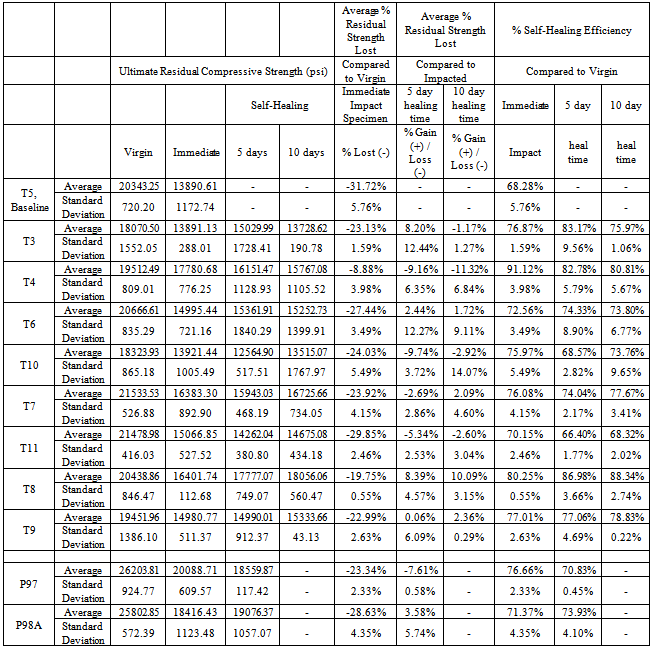-
Paper Information
- Previous Paper
- Paper Submission
-
Journal Information
- About This Journal
- Editorial Board
- Current Issue
- Archive
- Author Guidelines
- Contact Us
International Journal of Composite Materials
p-ISSN: 2166-479X e-ISSN: 2166-4919
2013; 3(6): 145-155
doi:10.5923/j.cmaterials.20130306.02
Self-healing Fiber-reinforced Epoxy Composites: Solvent-epoxy Filled Hollow Glass Fibers
Narinder K. Mehta
Department of Chemical Engineering, University of Puerto Rico, Mayagüez, PR 00681 USA
Correspondence to: Narinder K. Mehta, Department of Chemical Engineering, University of Puerto Rico, Mayagüez, PR 00681 USA.
| Email: |  |
Copyright © 2012 Scientific & Academic Publishing. All Rights Reserved.
Functional repair components encased inside hollow glass fibers (HGFs) are being considered as self-healing systems for advanced composite structures. This study describes the resulting compressive residual strength of impacted composite laminates embedded with solvent-epoxy resin-filled HGFs, which provided a self-healing functionality. The healing efficiency was found to be 73-88% after 10 days self-recovery time; it was highest for the embedded HGFs containing ethyl cyanoacrylate as the healing agent. This work has provided evidence that for the HGFs lay-up investigated, a significant fraction of the lost compression strength can be successfully restored by the self-repairing effect of the healing chemicals, suggesting that self-repair is possible for advanced composite structures.
Keywords: Self-healing, A. Polymeric-matrix Composites, A. Smart Materials, B. Damage Tolerance
Cite this paper: Narinder K. Mehta, Self-healing Fiber-reinforced Epoxy Composites: Solvent-epoxy Filled Hollow Glass Fibers, International Journal of Composite Materials, Vol. 3 No. 6, 2013, pp. 145-155. doi: 10.5923/j.cmaterials.20130306.02.
Article Outline
1. Introduction
- Advancements in materials research have resulted in remarkable growth in the field of smart, inventive materials[1-6] capable of mechanical/damage healing of engineering structures in response to an applied stimulus. New developments in the state-of-the art research have come out in recent years on self-healing fiber-reinforced structural polymer composite embedded a variety of novel solvents and chemical filled glass fibers and microcapsules among others[7-12]. Recent work on autonomic healing[11] at room temperature yielded as much as 45% recovery of virgin interlaminar fracture toughness, while healing at 80℃ increases the recovery to over 80%. A comprehensive review[1] in the field of stimuli-responsive healable materials suggests the examination of the healing of polymeric materials, briefly discussing the conventional techniques for repair and maintenance of composite materials.A perspective on the use of multidimensional microvascular network for healing applications for future self-healing approaches using a biomimetric technique is discussed[10]. Again, hollow fiber and microencapsulation approaches are new types of self-healing technology and have been emerging at an increase rate over the last decade. The intention is to stimulate debate and reinforce the importance of a multidisciplinary approach in the exciting field. Shape memory polymer fibers[12] have also been used in a biomimetic two-step self-healing system for healing microscopic cracks. Also a new healing mechanism is proposed[7] for composite networks, based on the dissipation of constraints that hinder fluctuation of network junctions.The focus in the development of these materials is to address their susceptibility to impact damage. Damage to the polymer matrices at the macroscopic level leads to matrix micro-cracking and delamination within the bulk of the composite and thus alters its mechanical properties. Even thermal, electrical and acoustic properties change as matrix cracks are initiated. Matrix micro-cracking, fiber-matrix debonding and delamination are dangerous because a micro-crack may act as a nucleation site; it may propagate, resulting in premature major structural failure if the damage is not detected and repaired. Hence, it becomes a necessity to autonomically repair cracks within a composite to retain the structural integrity and extend the lifetime of the material. Fiber-reinforced epoxy-based polymer composites are leading the way to improve the efficiency and sustainability of structures. Highly cross-linked polymeric materials are required to achieve the mechanical strength desired for these structures; however, these types of materials tend to be brittle and are prone to the development of cracks through normal usage, which may result in catastrophic failure. Low energy impact can result in a drastic reduction in the composite strength, elastic moduli, structural durability and damage tolerance characteristics. However, these self-healing polymeric materials offer the ability to extend the functional lifetime of these structures.It is crucial to be concerned about the complexity of impact damage initiation and propagation in composite matrices because the repair strategy will have to cope with several mechanisms and factors that can affect the nature and magnitude of the impact damage. Structural failures have pushed the scientific community to explore mechanisms to retard and repair microscopic cracks before irreversible damage is done to the material. Smart materials are able to achieve self-healing[10, 13-15] either by reversibly bonding the broken structure or via an embedded healing agent in the composite structure. It is ideal to utilize a methodology that can be executed quickly and effectively on site. Matrix cracking can be repaired by sealing the crack with an embedded resin or appropriate solvents. Bleeding of embedded functional chemicals doped with a UV dye may serve as a biomimetic (12) simulation for synthetic self-repair systems. Our aim is to ascertain the efficiency of the healing reagents with the dye infiltrating the damaged site and bridging the fractured surfaces. This feasibility study is focused on experimental work on the self-healing of impacted epoxy composites embedded with HGFs containing healing agents spiked with a fluorescent dye. The role of the fiber in reinforced plastics is to add strength and stiffness to the polymer matrix, but healing agents[5] stored in HGFs and placed inside the composite matrix provide the ability to repair a damaged matrix independently of any external stimulus. The performance of the self-healing method described above is evaluated using compression mechanical testing of the impacted laminate specimens. The results regarding the extent of the healing efficiency and the recovery of the original mechanical integrity under impact stress (compression) are presented.
2. Methods and Materials
2.1. Self-healing Concept
- The concept of self-repair in composite structures is similar to the biological healing process in living organisms; the key is that no external action is required. The technology must sense and respond to damage to restore the system’s original properties. Self-healing is a novel alternative to damage tolerant design and removes the need to perform temporary repairs to damaged structures; at the same time, it provides an opportunity to improve designs, allowing for fiber-reinforced composites. Self-healing laminate, in this work, is defined as a standard composite laminate with self-healing materials (filled HGFs) placed in layers at predetermined spaces and introduced at critical interfaces[6]. Early damage detection is important, as is the ability to restore structural strength and stiffness to a composite structure after damage has occurred. The novel concept is that of “self-repair”, where a damaged structure is repaired by materials already contained within the structure. This repair involves sealing the impact cracks, followed by solvent-epoxy-amine curing of the cracks, leading to a recovery of mechanical properties similar to that of the un-cracked composite. One approach to mechanically simulated self-healing systems utilizes epoxy resin (a composite matrix material) as the healing agent because it is probable that there is enough residual amine (hardener) available in the composite matrix to help the polarization process to occur, thus filling the crack and restoring the strength of the material.The healing mechanism involves wetting[15, 16] of the impacted polymer surface using solvents. The embedded self-healing chemicals in HGFs are released in the crack plane upon impact damage and help restore the initial fracture properties. When HGFs are broken by impact, the released solvent swells the nearby matrix and thus allows residual amines to further cross link with residual epoxy functionalities. However, additional epoxy resin within the broken HGFs (if embedded) augments the chance for additional cross-linking and may help bond new thermoset to the original matrix interface. The important point to consider is the ability of the repair agent to adequately reach the damaged site and commence healing.
2.2. Reagent Grade Organic Solvents
- Solvents assist in the healing behavior mainly by wetting the polymer surface and swelling the bulk polymer. Self-healing chemicals can repair damage in thermosets through chemical reactions at room temperature, or in an autonomic way using filled HGFs or microcapsules with appropriate solvent-epoxy mixtures or stand-alone chemicals. It is important that the chemicals do not react with the epoxy and have a low viscosity in liquid form for easy filling of the hollow fiber tubes. Not all solvents are suitable as healing agents. Solvents with dielectric constants (DCs) ranging from 5-50 are ideal. Encouraging self-repair recovery results with the use of aprotic polar solvent-filled microcapsules embedded in thermoset composites have been reported in the literature[16, 17]. This suggested a more detailed exploration of the feasibility of using some aprotic polar solvents in combination with the epoxy resin in HGFs to serve as an autonomic self-healing system.The hydrogen bond accepting ability of the aprotic polar solvents[16] is the probable explanation for the self-healing recovery. The reacting epoxy resin contains a large number of free hydroxyl groups that serve as hydrogen bond donors. The dipole-dipole interaction between hydrogen bond accepting solvents and the free available amines in the composite also influences the epoxy-amine curing reaction. The self-healing system requires that the solvent be available in the epoxy matrix because the solvent plasticizes the epoxy resin to allow molecular mobility, promoting further curing reactions and cross-linking.
2.2.1. Ethyl Phenyl Acetate (EPA) and Nitrobenzene
- Polar aprotic solvents such as EPA, chlorobenzene and nitrobenzene are good candidates compared to other solvents such as non-polar hexane, which does not provide any indication of recovery of mechanical integrity[16]. Due to its toxicity, chlorobenzene was not considered in this work. EPA and nitrobenzene have DCs in the range of ~5-32 and a similar polarity to that of chlorobenzene (DC ~6), which has been previously shown to provide self-healing to composites after impact damage. Approximately 19-80 wt% of these solvents mixed with epoxy resin were used to fill the HGFs.
2.2.2. Methacrylic Acid
- High-impact toughness is an important physical property of a class of copolymers known as ionomers, where the bulk properties are governed by ionic interactions within the polymer. It has been suggested that acid groups in the molecular backbone of this material provide the synergy of the thermo-mechanical properties necessary for the healing behavior[1, 18]. The acid may allow adequate heat generation during impact, providing elastic retardation (viscoelastic response) and sealing, which may yield impact reversal in polymer composites. 20 wt% methacrylic acid-epoxy resin was used to fill the HGFs for evaluation following an impact event on composite laminate specimens.
2.2.3. Ethyl Cyanoacrylate (Superglue)
- This commercial thermoplastic compound was selected to serve as a sealing/healing agent for filling the HGFs. This is a cement-type material and has natural brittleness. It was envisioned that the tensile cracking of the epoxy matrix and the breaking of the glass fibers may stimulate the curing mechanism in this stand-alone healing system. This product (as supplied) had a low viscosity (<30 cP) with high air curing properties.
2.3. Epoxy/Hardener System
- Epoxy is widely used as a polymer in composites for diverse industry/engineering applications. Most fiber-reinforced epoxy thermosets use two-part components that create a glassy polymer network with a high material strength and stiffness when cured. These composites are brittle and prone to matrix micro-cracking under service load conditions. The function of the matrix is to secure the reinforcement and to facilitate load-transfer to the fibers. The epoxy matrix used was SC 15 Part A (a mixture of diglycidyl ether of bisphenol A, aliphatic diglycidyl ether: 10-20% and epoxy toughener: 10-20%), and the hardener was SC 15 Part B (a mixture of cycloaliphatic amine: 65-90% and proprietary amine: 10-35%). They were mixed in the stoichiometric ratio of 100 parts epoxy resin to 30 parts amine hardener. These products are specialized chemicals manufactured for high impact ballistic studies.
2.4. Capsule-embedded Specimens
- These specimens are the result of ongoing work at the Army’s CERL-ERDC composite laboratory to evaluate the self-healing recovery performance of impacted specimens embedded with microcapsules. The panels were made with a urea-formaldehyde capsule shell filled with SC-15 Part A epoxy resin. The capsules were sprinkled on each of the E-glass fiber sheets (10 and 15 wt %) before fabricating the composite laminates. The compressive residual strength testing was performed similar to the HGF-embedded specimens.
2.5. Hollow Glass Fibers (HGFs)
- Impact-induced damage can often be difficult to detect and frequently gives rise to internal damage in the form of delamination and matrix cracking. However, smart revealing systems have been developed to detect damage within the composite. A liquid repair system can be embedded within brittle-walled containers (like HGFs) that are fractured during impact, allowing the liquid healing agent to flow into the areas of damage where it subsequently cures.HGF-reinforced glass plies provide some degree of shielding under impact, absorbing energy and protecting the underlying material; they are also ideal to store self-healing functional materials. If a fluorescent dye[19] is incorporated within the compounds in HGFs, it provides enhanced visualization of the damaged site by the bleeding action[20] of a highly crack-penetrating medium to the micro-crack site. In some cases, acetone can be used to reduce the resin viscosity to facilitate the capillary action during the infiltration process and the bleeding effect during the self-repair.Hollow fibers are an ideal medium to provide a good combination of the storage and mechanical reinforcement functions of healing agents. A healing agent passes from within any broken HGF to infiltrate the impact-damaged zone and acts to improve the mechanical properties. This repair process will help reduce the critical effects of matrix cracking and delamination between plies, thus preventing further damage propagation. HGFs are the preferred choice for self-repair compared to embedded capsules due to their ability to store functional agents that impart a self-healing functionality to the laminate. Polymeric materials with fillers may perform poorly under impact loading. HGFs filled with a healing agent would not only add the desired strength (no reinforcing function) to the system but would permit self-healing of the damage, thanks to the materials embedded within the resin matrix in the composite structure. Following a mechanical stimulus (fracture), the healing agent would bleed into the damaged site to initiate repair.
2.5.1. Filling HGFs with Healing Agents
- HGFs have been shown to augment the structural performance of composite structures without creating sites of weakness within the composite. To implement the repair mechanism of HGFs, a practical technique must be developed for filling them with the repair chemicals. The HGF diameter, wall thickness and fiber hollowness, as well as the viscosity of the healing materials and the healing kinetics, play an important role in the healing process. Kimble Chase borosilicate glass capillary tubes of ~ 08-1.1 mm diameter x 10 cm length were used for this study.To fill an HGF tube with low viscosity fluids, the glass capillary was held almost horizontally with one of the open ends placed into the sealing agent, which flows into the glass by capillary action. A hand-held pump was used, which resulted in a difficult and messy scenario for filling the hollow fibers. Ethyl cyanoacrylate[14] was used as one of the healing agents to fill HGFs, supplied by the vendor in a small plastic bottle. The bottle served as an exceptional mechanism to fill the hollow fiber tubes with different mixtures of solvent-epoxy healing agents. After filling, both ends of the tube were sealed with epoxy putty cured rapidly at room temperature (RT), inserted manually a few millimeters into the fiber lumens to prevent leaking of the healing mixture and reaction with air.EPA, nitrobenzene and methacrylic acid in combination with epoxy-resin were used to fill the HGFs, whereas ethyl cyanoacrylate was used as a stand-alone compound for filling the fiber tubes before adhering them to the fiber surface using epoxy glue.
2.6. Specimen Fabrication
- A standard resin film infusion process was used to fabricate the HGF-embedded epoxy composite laminates, which consisted of eight unidirectional plies to obtain a RT-cured thickness of ~0.5 mm with a stacking[21,22] sequence of[45°/0°/-45°/90°]symmetric. The designations represent a single layer (~ 4.57 x 4.57 cm of E-glass woven fabric with the warp and weft fibers oriented at the specified angles. Four precut sheets were placed in a pre-fabricated mold as per the above fiber orientation pattern. A precut carton panel with ~ 39.1 x 1.52 cm sections was placed on top of the four E-glass stacked sheets. Eleven hollow fiber tubes filled with solvent-epoxy mixtures were placed vertically (linear) into each of the 15 sections in a setting pattern of five tubes in the middle and three tubes on both sides, separated by ~ 1.27 cm of space, as shown in the figure 1 below. The lay-up was chosen to position the HGFs in the sub-surface of the E-glass fiber plies to provide a fully symmetric arrangement to avoid any detrimental residual stresses in the composite matrix. After placing the tubes on the fiber surface, they were adhered using epoxy glue; the glued HGFs were then allowed to dry overnight. The remaining four E-glass laminate sheets were placed over the set-up before starting the infusion process using a stoichiometric mixture of epoxy resin and hardener. The panel was left undisturbed for a curing of 2-3 days at the laboratory temperature. The whole fabricated panel (Figure 2) was precision cut to have fifteen ~ 10.1x15.2 cm specimens for compression testing after impact.
2.7. Impact Damage (Indentation) of the Specimens
- To establish the efficiency of the self-healing after impact damage, the specimens were prepared to establish the compressive residual strength behavior before and after the prescribed time intervals. The specimens were subjected to drop weight impact testing according to ASTM D7136D 7136M prior to the application of the compressive force. The specimens back side was subjected to impact damage by a process of indentation using a hardened steel tube with a hemi-spherical end ~ 4.63 mm in diameter falling from a height of ~ 122 cm with the specimen held tightly on a metal surface. A representative impact damage site was formed in the center of each specimen, and healing was allowed to take place at ambient laboratory temperature for a sufficient self-healing time before the compression testing to determine the effectiveness of the self-repair of the impacted site.
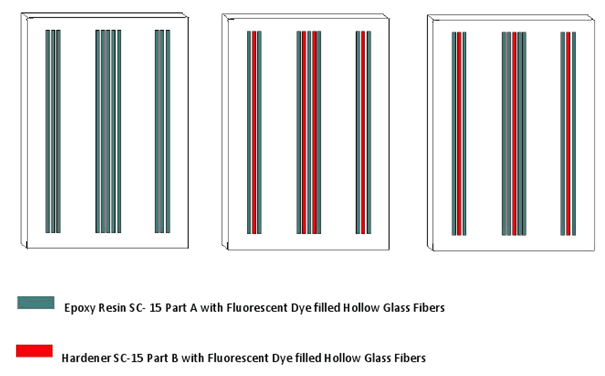 | Figure 1. Lay-up of the embedded HGFs in the composite laminate |
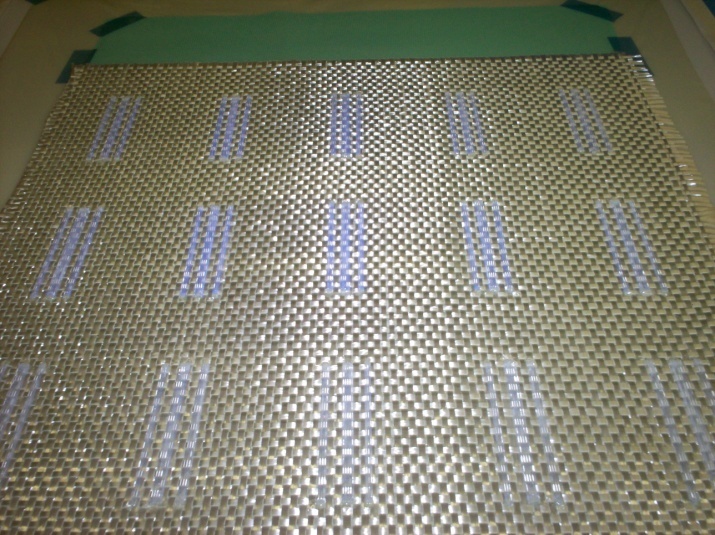 | Figure 2. Solvent-epoxy filled (with a fluorescent dye) HGFs glued on E-glass fiber sheets before infusion of the resin and hardener mixture |
3. Results
3.1. Indentation Behavior
- The majority of the impact-induced damage will be localized within or adjacent to the hollow fiber plies, thus creating an ideal scenario for self-repair agents (containing uncured resin) leaking out of the broken hollow fibers. The initiation of curing simultaneously promotes the infiltration of the healing agents in the local crack matrix by capillary action. The presence of solvents may alter the reaction mechanism and the curing speed due to temperature variations resulting from the heat absorbed by solvent evaporation. This may result in rendering the healing resin ineffective after a short period of time.
3.2. Evaluation of Damage Initiation
- As the back side of the specimens was indented, visual inspection revealed that the damage was widespread, with each ply interface having some level of damage throughout the thickness of the laminate near the area of the embedded HGFs. The damage probably will be interconnected; hence the self-healing materials will be able to penetrate into the damage plane. A key aspect of the whole self-healing process is that the impact energy must be of a threshold value to fracture the HGFs.The bleeding of the dye from within the fractured HGFs into the damaged areas is visible to some extent (Illustration 3) under a UV light source, thus demonstrating the effectiveness of the dye as a method for damage visualization. However, a more sophisticated instrumental setup, such as C-UV scan time controlled photography, is needed to comment on the dispersion-bleeding of the dye into the crack plane.
3.3. Damage Analysis
- Overview: The impact will probably create a localized crushing zone followed by shear cracks and delaminations of increasing length through the thickness of the laminate, culminating in the largest delamination at the back face between the final plies of the stack. The HGF clusters may cause the delamination to deviate from its path due to the fiber clusters and the resulting resin-rich regions causing a weakness in the laminate. Instead of passing directly through an HGF/matrix interface, the propagating crack may deviate around it, causing fiber rupture and the release of healing agents. HGFs are normally ruptured as a delamination propagates along a ply interface, suggesting that their susceptibility to fracture is similar to that of the matrix. Intra-ply shear cracks normally link multiple delaminations. The presence of these cracks is essential for self-repair, as they provide connectivity between different damage sites in the laminate and facilitate healing at multiple interfaces. Additionally, shear cracks would be expected to generate a large capillary action to transport healing components, as the capillary force generated is inversely proportional to the radius of the opening between the two interfaces.
3.4. Compressive Residual Strength after Impact
- To establish the baseline mechanical performance and damage levels anticipated in the HGF-embedded composite panels, compression testing after the impact tests was carried out on precut impacted and non-impacted test specimens. The purpose of this compression force test was to evaluate the ability of the healing solvent-epoxy resin mixture to repair matrix cracking and delamination damage. Because the back face is the primary location of the impact damage, it was loaded in compression mode for every impacted sample.The ASTM D6264/D 6264M test method was used to test the residual compression properties of the multidirectional E-glass polymer matrix composite laminate specimens. The method utilizes a flat, rectangular ~10.2 x 15.2 cm composite laminate plate, previously subjected to a damaging event. Applied force data were recorded while loading. Susceptibility to damage from concentrated out-of-plane forces is one of the major design concerns of structures made of advanced composite laminates. Compressive residual strength data obtained by this method may reflect the damage tolerance characteristics of an un-stiffened monolithic skin that resists out-of-plane deformation. A PC-based data acquisition system was used for all compression testing.Ultimate compressive residual strength, psi = Pmax / APmax = maximum force prior to failure, N[lb·30.5 cm]A = cross-sectional area = h (2.54 cm) x w (2.54 cm) x T (2.54 cm2)
3.4.1. Compressive Residual Strength Data
- The ASTM residual compression methodology approach to assess the effect of self-healing was used to directly compare the effect of the HGF layers on the baseline laminate and assess the healing capability. Inclusion of the HGFs will increase the thickness of the laminate around the areas where they are embedded. It may reduce the fiber fracture due to localized crushing of the HGFs under the impact site; this will appear as a darker central region of the type seen in Figure 3 A-D. All testing was undertaken with the damaged face of the specimen subjected to compressive loading. This was because the resin repair would have a negligible effect on the fiber-dominated tensile face.
 | Figure 3A-D. Virgin, compressed, un-impacted and impacted test specimens |
|
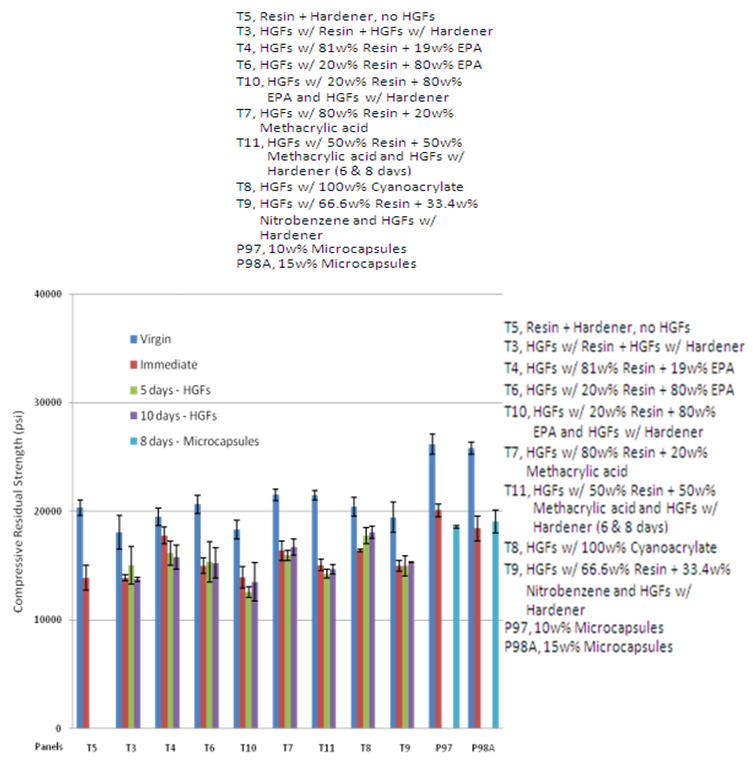 | Figure 4. Ultimate Compressive Residual Strength after Impact |
3.4.2. Self-healing Efficiency Data
- The self-healing efficiency is defined as the fracture compressive load ratio[23] of the healed and the virgin fracture toughness. Figure 6 demonstrates an average self - healing or crack efficiency of 88% for ethyl cyanoacrylate (panel T8) specimens, 79% for nitrobenzene-epoxy (panel T9) specimens and 76% for methacrylic acid-epoxy (panel T7) specimens after 10 days of recovery time, whereas 15 wt% capsules provided a 74% self-healing efficiency on average after eight days of recovery time. More data are needed to evaluate the performance of the chemical-containing capsules as potential candidates for self-healing of thermoset composites after impact damage.On the basis of the test results, it is realistic to suggest that for impact damage recovery applications, solvent-epoxy filled HGFs embedded in epoxy composite laminates is extremely cost-effective and should be a preferred choice, as HGFs provide an enhanced, quick and autonomic self - healing of the cracked and damaged thermoset matrix.
 | Figure 5. % Loss Residual Strength after Impact (Immediate) |
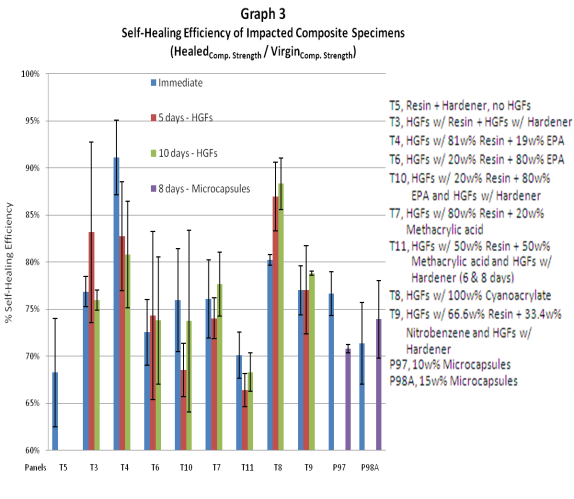 | Figure 6. Self-Healing of Impacted Composite Specimens (HealedComp.Strength / VirginComp.Strength) |
4. Conclusions
- This work has shown that a hollow glass fiber self-healing approach can be used to repair advanced composite structures. It has shown that HGFs containing solvent-epoxy mixtures as self-repair agents can be embedded into composite laminates. A series of mechanical tests were undertaken to evaluate the influence of the incorporated HGFs on the compressive strength. The results have shown that for the lay-up of HGFs investigated, a significant fraction of lost compressive strength can be restored by the self-repairing effect of the solvent-epoxy/chemical agents stored within the embedded HGFs. The self-repair mechanism is not a permanent solution, but provides a means to inhibit further damage propagation.The results have indicated that the inclusion of HGFs gives an initial compressive strength reduction of 19-30%. It was found that the baseline laminate and the laminates containing HGFs had comparable low energy impact damage tolerance both in terms of damage size and immediate residual compressive failure strength (typically 70-80%). After self-healing of the damaged impact site for five and 10 days, it was found that the self-healing efficiency of the healed specimens with different combinations of solvent-epoxy mixtures inside the HGFs ranged from 73 to 88% compared to undamaged virgin laminate specimens. The results suggest that self-healing is possible for advanced composite structures using aprotic polar solvents and chemicals. The passive system demonstrated heals matrix micro-cracks and may prevent crack reopening and further crack growth.The self-repair ability may deteriorate over time as the repair chemicals such as resin degrade. Further work is needed to optimize the selection of healing agents, composite and resins, including ionomers within HGFs, to provide increased environmental stability and effective service life. Efforts are also needed to refine both the self-repairing and damage enhancement processes (equipment) by using tailored resins and dyes which may provide improved repair properties.One must recognize that curing by ethyl cyanoacrylate on contact within the mouth of the capillary may prevent the use of this type of material as a repair resin in small diameter HGF systems. However, careful manipulation of the materials may provide excellent results, as demonstrated in this work. We used a compound with a reduced viscosity of ~5 cP, and it provided encouraging data to further explore the use of this compound as a stand-alone self-repair agent. The research has indicated the importance of choosing an appropriate combination of repairing resin and solvents to offer ease of infiltration into the damaged site, excellent curing characteristics and adequate mechanical properties once cured.
ACKNOWLEDGMENTS
- The author (retired professor) is grateful to Dr. Ashok Kumar and Dr. Larry D. Stephenson of the U. S. Army’s ERDC-CERL, Champaign, Illinois for the summer funding support and to William Lewis for his help in carrying out the immense work-load involved in this short summer project.The research was supported in part by an appointment to the 2010 Faculty Research Participation Program at the U. S. Army Engineer Research and Development Center, Corps of Engineers Construction Engineering Research Laboratory (ERDC-CERL), administered by the Oak Ridge Institute of Science and Education (ORAU/ORISE) through an interagency agreement between the U. S. Department of Energy (DOE) and ERDC-CERL.
 Abstract
Abstract Reference
Reference Full-Text PDF
Full-Text PDF Full-text HTML
Full-text HTML